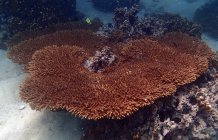
Tagged coral (Acropora downingi) colony hosts newly discovered symbiotic algae. Photo credit Wiedenmann, Burt, D’Angelo.
Scientists describe a new alga that may help corals adapt to climate change
Changes in ocean chemistry associated with climate change are exacerbating the global decline of coral reefs.
In a recent publication in Nature Scientific Reports, the University of Exeter’s Dr. Jamie Stevens, in collaboration with scientists from the UK and Abu Dhabi, used molecular techniques to examine the prevalence of heat-tolerant algae living in and interacting with corals, and identified a new alga - Symbiodinium thermophilum in six common coral species from the Persian/Arabian Gulf.
Corals form mutually-beneficial relationships with Symbiodinium - microscopic, single-celled algae - that reside within its tissues. These algae are sensitive to environmental fluctuations, particularly increases or decreases in sea temperature. ‘Coral bleaching’ occurs when corals expel these algae during stressful periods, leaving them with a white or ‘bleached’ appearance. However, some coral species in warmer seas like the Persian/Arabian Gulf have adapted to higher temperatures. Understanding the strategies used by corals from this region may shed light on their capacity to survive forecasted climate change scenarios.
Symbiodinium are categorised in different ‘clades’- genetically-distinct groups that may help to explain heat tolerance in various coral species. Corals possessing clade D Symbiodinium are thought to be heat-resistant, but were not the most common species examined in this study.
Analysis of a widely sequenced region of DNA (ITS2) showed that, instead, subclade C3, a heat-sensitive algal species, was most prevalent. The authors analysed this subclade (ITS2 C3) to investigate seasonal variation in dominant Symbiodinium species, and to determine whether genetically-distinct species exist in common coral species from the Persian/Arabian Gulf. Their results showed that most corals from this region contain C3 Symbiodinium as the dominant species throughout the year, with more varied algal species present during months with lower sea temperatures.
When asked about the significance of this research, Dr. Jamie Stevens, Associate Professor of Molecular Systematics in Biosciences said, "Corals of the Gulf and their associated endosymbiont communities appear to offer some hope for the future of reefs in a warming world, and corals originating in this region are attracting much interest as potential sources of re-seeding material for reefs damaged by thermal stress events. What will be interesting now is to explore the range of temperatures over which these coral communities can continue to thrive."
“It gives us hope to find that corals have more ways to adjust to stressful environmental conditions than we had previously thought,” stated Professor Wiedenmann, main investigator and co-author from the University of Southampton. “However, it is not only the heat that threatens the survival of coral reefs but also pollution and nutrient enrichment, overfishing and coastal development. Only if we manage to reduce these different forms of stress will the corals be able to benefit from their capacity to adjust to climate change.”
Date: 7 April 2015
